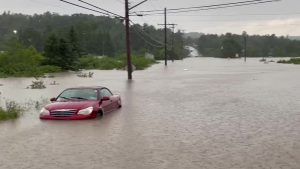
Map from HRM Document showing Areas 1&12
View: Housing Developments Approved for Bedford West
Nova Scotia Government. News Release, Municipal Affairs and Housing November 28, 2023
“On the recommendation of the Executive Panel on Housing in the Halifax Regional Municipality, Municipal Affairs and Housing Minister John Lohr has granted approvals that will enable the development of up to 2,060 homes in the following sub-areas of Bedford West:
– Bedford West 10 (subsections B and C)…
– Bedford West 1 and 12 – Phase 1; the proposed development by MICCO WBHL Developments GP Limited includes up to 579 residential units consisting of 470 apartments and 109 townhomes and semi-attached or single-family units
– Bedford West 1 and 12 – Phase 3;…”
Bedford West 1&12 enclose some of the headwaters for Sandy Lake
An article by Linden Thomas in The Signal, Dec 1, 2023: Fast-tracked development in Bedford raises environmental concerns provides a good overview of the related environmental concerns.
Some extracts From that article:
A fast-tracked housing development in Bedford could allow a critical wildlife passageway near Blue Mountain Birch Cove Lakes wilderness area to be bulldozed…Karen McKendry, senior wilderness outreach co-ordinator for the Ecology Action Centre, said developers could bulldoze a 100-metre tract of wilderness that is allowing wildlife to travel between Blue Mountain Birch Cove Lakes wilderness area and Sandy Lake Park.
Richard leBrasseur, director of the Green Infrastructure Performance Lab at Dalhousie University, is concerned about the potential survival of amphibians such as salamanders and reptiles such as snakes. The eastern ribbon snake is a threatened species in Nova Scotia.
Robinson said the development will increase road salt and debris in nearby waterways that are connected to Sandy Lake through a network of rivers and streams. “[If] they change the temperature and the pollution levels in Sandy Lake by developing, then the salmon will go again because they can’t stay in a place unless it has particular qualities,” Robinson said.
Retired Dalhousie University biology professor David Patriquin argues larger forested setbacks around the wetlands can hold water, protecting the development from flooding. “Until we had these extreme rains, we didn’t really appreciate how much these wetlands protect us,” says Patriquin, referencing the municipality’s floods last July.
Bedford city councillor Tim Outhit said he hadn’t expected the planning requirements to be so controversial. “[The buffer] was 20 metres, [and now] we’ve increased it to 30 metres, which should have made advocates a little happier and … developers a little bit happier,” said Outhit.
Also view: Regarding Case 23307 – Bedford West subareas 12 & 1 Special Planning Area 25Jul2023
Post on this website July 25, 2023.
Photos and some text from that post:
 Top: View of Northern edge of a large wetland in Bedford West subarea 12; it lies on a headwater stream for Sandy Lake. Bottom: Google map of the area Click on image for larger version Some important features of BW12&1 and just downstream:
… Conclusion: The impacts of development in BW12&1 and of BW12&1 in combination with proposed new development north of Hammonds Plains Road on Sandy Lake Water Quality, and on flooding downstream and if and how those might be mitigated have not been adequately assessed.  Bluewater Rd intersection with Hammonds Plains Rd. on July 22, 2023. Photo and related video (on facebook) by Kelly Regan. The white object is the roof of a communications cable van. It is especially important to take into account the extreme flooding we have experienced recently, and the trend year by year of more beach closures and increasing incidents of Blue Green Algae more broadly in HRM lakes, a reflection of climate warming and increasing urbanization. The 2022 McCallum Report recommended and Halifax Regional Council accepted the recommendation that riparian buffers in the area of the proposed expanded Sandy Lake Park, all above Hammonds Plains Road, be 50 m for wetlands and 100 m for watercourses to address critical water quality and wildlife issues. Logically and in the same context, riparian buffers in BW12&1 should likewise be 50 m for wetlands and 100 m for watercourses. These may seem excessive in relation to past requirements in HRM but we have learned the hard way that we need to do much better to protect our natural assets and the costs of not doing so. |
Comment
Reports Linden Thomas in The Signal article: “The province’s Municipal Affairs and Housing Department stated via email that “[fast-tracked developments] remov[e] barriers and will help thousands of people, at all income levels, access housing faster.”
When the “barriers” are such things as “wetland protection” and concerns about critical wildlife corridors, our current provincial government could do much better for all of us by seeking out already ecologically degraded sites or sites of much lower ecological value – of which there are many in the area – and fast tracking that process and subsequent development on those sites.
That way we could address the ‘Housing Crisis’ and the linked Climate & Biodiversity crises at the same time. HRM, with involvement of many citizens, had made a lot of progress on this direction, now dismissed by Houston & Co. rather than built upon for the good of the whole province, indeed, for the whole of Mother Earth.
